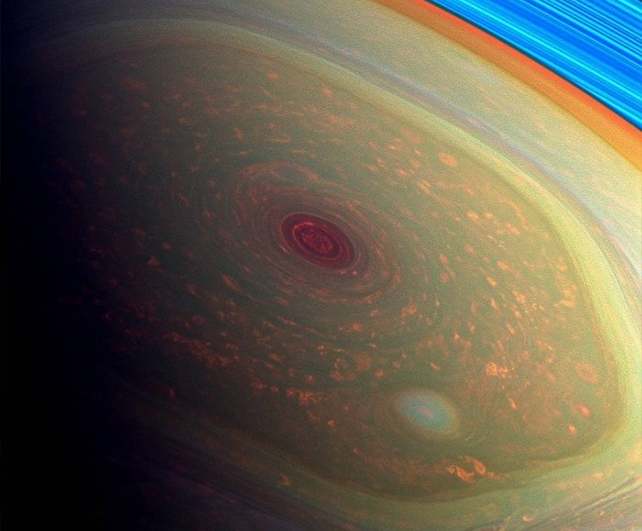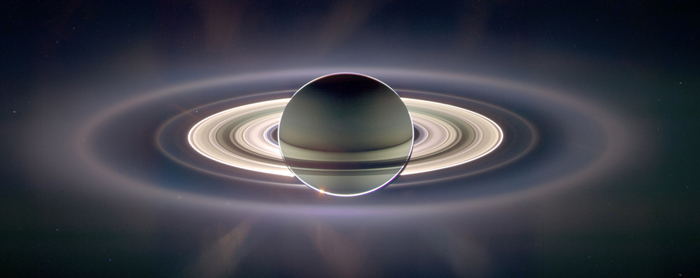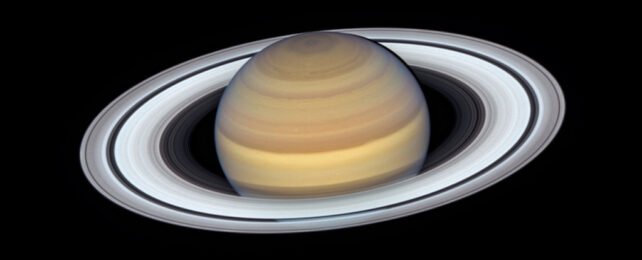Saturn is the sixth planet that orbits the Sun, positioned between Jupiter and Uranus at an average distance of just over 1.4 billion kilometers (about 886 million miles).
Known primarily for its majestic system of rings, Saturn also holds the record for the most number of moons, with 145 officially recognized satellites compared with a measly 92 orbiting Jupiter.
Studied with the naked eye since ancient times, much of what we know about the planet was given a boost by data collected by NASA's Cassini spacecraft. For 13 years the mission provided scientists with unprecedented levels of information on Saturn and its system of rings and moons, ending its mission in a spectacular dive into the atmosphere on 15 September 2017.
Slightly smaller than its neighbor Jupiter, Saturn could still swallow 700 Earth-sized worlds and have room left over for more. Yet its atmosphere of hydrogen with a splash of helium gives it a mass of just 95 times that of our own planet, making it the least dense of all the planets – so light, in fact, that it would float in a Saturn-sized sea of water.
Why is Saturn orange?
Traces of sulfur high in the giant's atmosphere give the planet a tanned orange color, with clouds of ammonia and water ice rising from the depths in monstrous storms to add streaks of white high in its cloud tops.
While not as dazzling as Jupiter's mottled stripes or its enormous rose-coloured tempest, Saturn has some hidden meteorological marvels of its own.
Its peculiarly shaped hexagonal storm could stand out as the strangest. First seen raging above Saturn's north pole in 1981, Cassini sent back fresh details on the ongoing maelstrom decades later. Planetary scientists used those details to piece together models of turbulence that could explain why such a geometrically beautiful pattern of swirling cloud could persist over the planet's pole.

What's more, a rain of liquid helium deep inside the atmosphere creates temperature conditions for a uniquely symmetrical magnetic field, while distributing heat in a rather unusual way that makes the planet's core warmer than might be expected.
Closer to the core, density rapidly increases, squeezing the gaseous hydrogen into a viscous substance with metallic properties. Exactly where this core starts and stops - and how it behaves - is largely unknown, though recent studies on the way it tugs ripples into the planet's rings suggest it's less a smooth sphere of compact material and more a fuzzy, oscillating blob.
Why does Saturn have rings?
Though the gas giant isn't the only ringed world in our Solar System, its iconic disks of ice, rocks, and dust stand out as the most striking and complex.
Initially the rings were mistaken for moons when observed by Galileo in 1610. Using a more powerful telescope, the Dutch astronomer Christiaan Huygens finally saw Saturn's rings for what they were in 1659.

Today we divide the system into seven major rings, labeled D, C, B, A, F, G, and E from the innermost ring out. It begins with the inside rim of D just under 10,000 kilometers from Saturn's cloud tops, and ends with the final wispy E ring stretching at least 420,000 kilometers (260,000 miles) out into space. As wide and majestic as the rings are, the clutter of small boulders, gravel, and dust is typically little more than 9 meters (30 feet) thick.
Exactly where this icy material came from is still unknown, with speculation ranging from the torn-up remains of a captured dwarf planet to material left over from Saturn's formation billions of years ago. By some estimates they may have formed as recently as just 100 million years ago, a fraction of the 4.5 billion years the Solar System has been around for.
Whatever their origins, we're privileged to see them at all. The icy material is slowly raining down onto Saturn's cloud tops. At the rate they're dispersing, they could be gone in as little as another 100 million years.
All Explainers are determined by fact checkers to be correct and relevant at the time of publishing. Text and images may be altered, removed, or added to as an editorial decision to keep information current.
